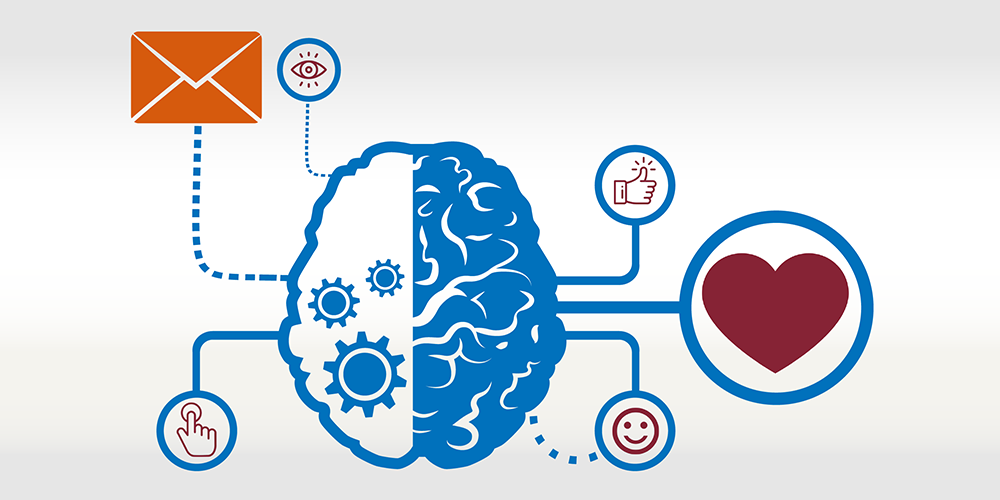Why is Direct Mail Effective? Brain Science.

Do you ever find yourself wondering, “why is direct mail effective?” Direct mail success lies deeper than a targeted list, pretty piece of creative and an especially convincing offer.
Direct mail campaign effectiveness is actually rooted in cognitive science. Neuroscience and behavioral science research have long investigated how the brain processes advertisements. Studies have revealed that direct mail is proven to subconsciously appeal to human emotions, boost brand recognition and drive purchase intent.
Here is a closer look at your brain on direct mail marketing, the science behind its performance, and why direct mail is effective at delivering unforgettable customer experiences.
The ‘cocktail party effect’ and personalization
While studying auditory perceptions, Colin Cherry discovered the ‘cocktail party effect’ in 1953.
Cherry’s studies showed that despite the acute clamor of sensory stimuli that often surrounds individuals engaged in a crowded social setting (such as a cocktail party), the human brain can focus one’s auditory attention on a particular conversation while tuning out all other background noise. This effect can also be used in reference to one’s ability to immediately detect words of importance outside of their current conversation, like hearing their name amid the buzz of ignored stimuli, and instantly tuning in to that exchange. Although incredibly complex, this cognitive phenomenon requires little conscious effort from the individual.
By harnessing the insights from Colin Cherry’s research, direct marketers can help their brand stand out in a crowded space. Similar to how overhearing your name at a cocktail party is an instant magnet for your brain, when a consumer receives a personalized and relevant advertisement, they simply can’t resist tuning in and will subconsciously gravitate towards its message.
Neuroscience and touch
In 2019, the USPS partnered with Temple University to analyze direct mail’s effectiveness and influence on consumers across all demographics. Researchers used neuromarketing techniques to gain insights on visual attention, emotional engagement, and brain activity to understand a person’s conscious and subconscious response to both print and digital advertisements. While both mediums have their advantages, print was proven to elicit a stronger emotional response, was more comprehensible and memorable, and made the products or services feel more desirable and valuable to the recipient than digital advertising.
Likewise, Sappi’s neuroscience research explored the sensory experience print advertising has on consumers. The studies confirmed that touch has an influential role in consumer decision-making and purchase behaviors, stating “84% of online orders originate from physical interactions with catalogs, magazine ads and direct mail.”
Considering the neuroscience research shared above, brands should recognize the impact a physical mail piece can have on brand perception and response rates. High-quality paper stocks, engaging textures or coatings, and personalized messaging will create an impactful customer experience and stimulate a memorable and meaningful connection.
Behavioral science and simplicity
Behavioral science combines psychology, sociology, and cultural anthropology to examine human behavior and decision making, recognizing humans do not make all decisions rationally. Principles from behavioral science research can assist direct marketers as they consider the customer journey and the brand messaging that guides consumers to take that next step.
In a recent Brand United presentation, behavioral science leader Shirin Oreizy explained how marketers can construct environments that attract consumers in their target audience to take a desired action based on the following behavioral science concepts:
- Friction: humans naturally prefer the path of least resistance.
- Working memory: the average adult brain can hold only 5-9 pieces of information at a given time.
- Cognitive fluency: the simpler the action, the more likely humans are to believe the message and adopt it.
- Narrative bias: humans have evolved to remember and relate to stories.
These concepts are highly relevant when creating mailers that will drive response. To design simplified and influential direct mail that leads recipients towards the desired action, optimize content with blocked relevant information, utilize relatable storytelling and personalized elements, and streamline online and offline environments for uncomplicated conversions.
Long-term memory and omnichannel campaigns
Many brands rely on a single form of marketing, such as digital advertisements, email marketing or social media. While maximizing your marketing efforts in one channel may seem like a cost-effective way to attract new customers, a mix of both online and offline advertising is the key to improving your return on investment in a digital world.
Not only do omnichannel campaigns give a recipient multiple ways to respond to your special offer, the repeated marketing message encodes itself into the recipient’s long-term memory bank – a predictor of future action. MarketReach neuroscience research found that when a consumer received a direct mail piece before seeing a cohesive social media advertisement, long-term memory encoding was 44% stronger. Additional neuroscience studies have shown that when direct mail follows digital interactions, brand recall and arousal rates increase by over 25%.
As marketers work to optimize online and offline marketing strategies, a strategic sequence of digital and direct mail touches will enhance the effectiveness and efficiency of both marketing channels and overall marketing campaign spend. A digital ad followed by a piece of mail with a QR code and an appealing call to action (CTA) will boost your customer satisfaction. Leverage the benefits of an integrated marketing strategy by testing to find the best performing digital and direct mail cadence for your brand.
_______
In a world saturated with digital marketing, grabbing a consumer’s attention takes a material touch. Direct mail works by creating an opportunity for brands to engage with their ideal customer with a tangible, influential and mindful media. With successful direct mail, members of your customer base can follow up on special offers, physical coupons, or digital touches. Check out our blog to learn more about why direct mail is effective, download this infographic, or contact us today to get started on your growth strategy.
Featured in BRAND United on 8.4.2020

